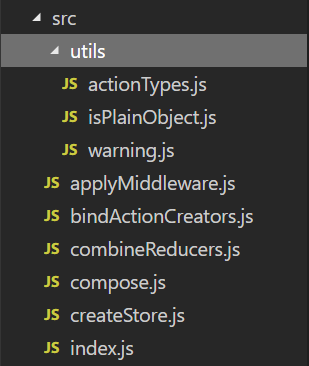前言
作为React全家桶的一份子,MVVM中的VM,Redux为react提供了严谨周密的状态管理。但Redux本身是有点难度的,虽然学习了React也有一段时间了,自我感觉算是入了门,也知道redux的大概流程。但其背后诸如createstore,applymiddleware等API背后到底发生了什么事情,我其实还是不怎么了解的,因此最近花了几天时间阅读了Redux的源码,写下文章纪录一下自己看源码的一些理解。(此文章会随着自己对redux的理解的加深持续更新改进)
一、源码结构(redux4.0版本)
Redux是出了名的短小精悍(恩,这个形容很贴切),只有2kb大小,且没有任何依赖。它将所有的脏活累活都交给了中间件去处理,自己保持着很好的纯洁性。再加上redux作者在redux的源码上,也附加了大量的注释,因此redux的源码读起来还是不算难的。
先来看看redux的源码结构,也就是src目录下的代码:

其中utils是工具函数,主要是作为辅助几个核心API,因此不作讨论。
(注:由于篇幅的问题,下面代码很多都删除了官方注释,和较长的warn)
二、具体组成
index.js是redux的入口函数具体代码如下:
2.1 index.js
1 | import createStore from './createStore' |
其中isCrushed函数是用于验证在非生产环境下 Redux 是否被压缩,如果被压缩就会给开发者一个 warn 的提示。
在最后index.js 会暴露 createStore, combineReducers, bindActionCreators, applyMiddleware, compose 这几个redux最主要的API以供大家使用。
2.2 creatStore
createStore函数接受三个参数:
- reducer:是一个函数,返回下一个状态,接受两个参数:当前状态 和 触发的 action;
- preloadedState:初始状态对象,可以很随意指定,比如服务端渲染的初始状态,但是如果使用 combineReducers 来生成 reducer,那必须保持状态对象的 key 和 combineReducers 中的 key 相对应;
- enhancer:是store 的增强器函数,可以指定为中间件,持久化 等,但是这个函数只能用 Redux 提供的 applyMiddleware 函数来进行生成
下面就是creactStore的源码,由于整体源码过长,且 subscribe 和 dispatch 函数也挺长的,所以就将 subscribe 和 dispatch 单独提出来细讲。
1 | import $$observable from 'symbol-observable' |
subscribe
1 | function subscribe(listener) { |
有时候有些人会觉得 store.subscribe 用的很少,其实不然,是 react-redux 隐式的为我们帮我们完成了这方面的工作。subscribe 函数可以给 store 的状态添加订阅监听,一旦我们调用了 dispatch 来分发 action ,所有的监听函数就会执行。而 nextListeners 就是储存当前监听函数的列表,当调用 subscribe,传入一个函数作为参数时,就会给 nextListeners 列表 push 这个函数。同时调用 subscribe 函数会返回一个 unsubscribe 函数,用来解绑当前传入的函数,同时在 subscribe 函数定义了一个 isSubscribed 标志变量来判断当前的订阅是否已经被解绑,解绑的操作就是从 nextListeners 列表中删除当前的监听函数。
dispatch
dispatch是redux中一个非常核心的方法,也是我们在日常开发中最常用的方法之一。dispatch函数是用来触发状态改变的,他接受一个 action 对象作为参数,然后 reducer 就可以根据 action 的属性以及当前 store 的状态,来生成一个新的状态,从而改变 store 的状态;1
2
3
4
5
6
7
8
9
10
11
12
13
14
15
16
17
18
19
20
21
22
23
24
25
26
27
28
29
30
31
32
33
34
35function dispatch(action) {
// action 必须是一个对象
if (!isPlainObject(action)) {
throw new Error(
......
)
}
// type必须要有属性,不能是undefined
if (typeof action.type === 'undefined') {
throw new Error(
......
)
}
// 禁止在reducers中进行dispatch,因为这样做可能导致分发死循环,同时也增加了数据流动的复杂度
if (isDispatching) {
throw new Error('Reducers may not dispatch actions.')
}
try {
isDispatching = true
// 将当前的状态和 action 传给当前的reducer,用于生成最新的 state
currentState = currentReducer(currentState, action)
} finally {
// 派发完毕
isDispatching = false
}
// 将nextListeners交给listeners
const listeners = (currentListeners = nextListeners)
// 在得到新的状态后,依次调用所有的监听器,通知状态的变更
for (let i = 0; i < listeners.length; i++) {
const listener = listeners[i]
listener()
}
return action
}
2.3 compose.js
compose 可以接受一组函数参数,从右到左来组合多个函数,然后返回一个组合函数。它的源码并不长,但设计的十分巧妙:1
2
3
4
5
6
7
8
9
10
11
12
export default function compose(...funcs) {
if (funcs.length === 0) {
return arg => arg
}
if (funcs.length === 1) {
return funcs[0]
}
return funcs.reduce((a, b) => (...args) => a(b(...args)))
}
compose函数的作用其实其源码的注释里讲的很清楚了,比如下面这样:
1 | compose(funcA, funcB, funcC) |
其实它与这样是等价的:
1 | compose(funcA(funcB(funcC()))) |
ompose 做的只是让我们在写深度嵌套的函数时,避免了代码的向右偏移。
2.4 applyMiddleware
applyMiddleware也是redux中非常重要的一个函数,设计的也非常巧妙,让人叹为观止。
1 | export default function applyMiddleware(...middlewares) { |
通过上面的代码,我们可以看出 applyMiddleware 是个三级柯里化的函数。它将陆续的获得三个参数:第一个是 middlewares 数组,第二个是 Redux 原生的 createStore,最后一个是 reducer,也就是上面的…args;
applyMiddleware 利用 createStore 和 reducer 创建了一个 store,然后 store 的 getState 方法和 dispatch 方法又分别被直接和间接地赋值给 middlewareAPI 变量。
其中这一句我感觉是最核心的:1
dispatch = compose(...chain)(store.dispatch)
我特意将compose与applyMiddleware放在一块,就是为了解释这段代码。因此上面那段核心代码中,本质上就是这样的(假设…chain有三个函数):
1 | dispatch = f1(f2(f3(store.dispatch)))) |
2.5 combineReducers
combineReducers 这个辅助函数的作用就是,将一个由多个不同 reducer 函数作为 value 的 object 合并成一个最终的 reducer 函数,然后我们就可以对这个 reducer 调用 createStore 方法了。这在createStore的源码的注释中也有提到过。
并且合并后的 reducer 可以调用各个子 reducer,并把它们返回的结果合并成一个 state 对象。 由 combineReducers() 返回的 state 对象,会将传入的每个 reducer 返回的 state 按其传递给 combineReducers() 时对应的 key 进行命名。
下面我们来看源码,下面的源码删除了一些的检查判断,只保留最主要的源码:1
2
3
4
5
6
7
8
9
10
11
12
13
14
15
16
17
18
19
20
21
22
23
24
25
26
27
28export default function combineReducers(reducers) {
const reducerKeys = Object.keys(reducers)
// 有效的 reducer 列表
const finalReducers = {}
for (let i = 0; i < reducerKeys.length; i++) {
const key = reducerKeys[i]
const finalReducerKeys = Object.keys(finalReducers)
// 返回最终生成的 reducer
return function combination(state = {}, action) {
let hasChanged = false
//定义新的nextState
const nextState = {}
// 1,遍历reducers对象中的有效key,
// 2,执行该key对应的value函数,即子reducer函数,并得到对应的state对象
// 3,将新的子state挂到新的nextState对象上,而key不变
for (let i = 0; i < finalReducerKeys.length; i++) {
const key = finalReducerKeys[i]
const reducer = finalReducers[key]
const previousStateForKey = state[key]
const nextStateForKey = reducer(previousStateForKey, action)
nextState[key] = nextStateForKey
hasChanged = hasChanged || nextStateForKey !== previousStateForKey
}
// 遍历一遍看是否发生改变,发生改变了返回新的state,否则返回原先的state
return hasChanged ? nextState : state
}
}
2.6 bindActionCreators
bindActionCreators可以把一个 value 为不同 action creator 的对象,转成拥有同名 key 的对象。同时使用 dispatch 对每个 action creator 进行包装,以便可以直接调用它们。
bindActionCreators函数并不常用(反正我还没有怎么用过),惟一会使用到 bindActionCreators 的场景就是我们需要把 action creator 往下传到一个组件上,却不想让这个组件觉察到 Redux 的存在,并且不希望把 dispatch 或 Redux store 传给它。1
2
3
4
5
6
7
8
9
10
11
12
13
14
15
16
17
18
19
20
21
22
23
24
25
26
27
28
29// 核心代码,并通过apply将this绑定起来
function bindActionCreator(actionCreator, dispatch) {
return function() {
return dispatch(actionCreator.apply(this, arguments))
}
}
// 这个函数只是把actionCreators这个对象里面包含的每一个actionCreator按照原来的key的方式全部都封装了一遍,核心代码还是上面的
export default function bindActionCreators(actionCreators, dispatch) {
// 如果actionCreators是一个函数,则说明只有一个actionCreator,就直接调用bindActionCreator
if (typeof actionCreators === 'function') {
return bindActionCreator(actionCreators, dispatch)
}
// 如果是actionCreator是对象或者null的话,就会报错
if (typeof actionCreators !== 'object' || actionCreators === null) {
throw new Error(
... ...
}
// 遍历对象,然后对每个遍历项的 actionCreator 生成函数,将函数按照原来的 key 值放到一个对象中,最后返回这个对象
const keys = Object.keys(actionCreators)
const boundActionCreators = {}
for (let i = 0; i < keys.length; i++) {
const key = keys[i]
const actionCreator = actionCreators[key]
if (typeof actionCreator === 'function') {
boundActionCreators[key] = bindActionCreator(actionCreator, dispatch)
}
}
return boundActionCreators
}
小节
看一遍redux,感觉设计十分巧秒,不愧是大佬的作品。这次看代码只是初看,往后随着自己学习的不断深入,还需多加研究,绝对还能得到更多的体会。